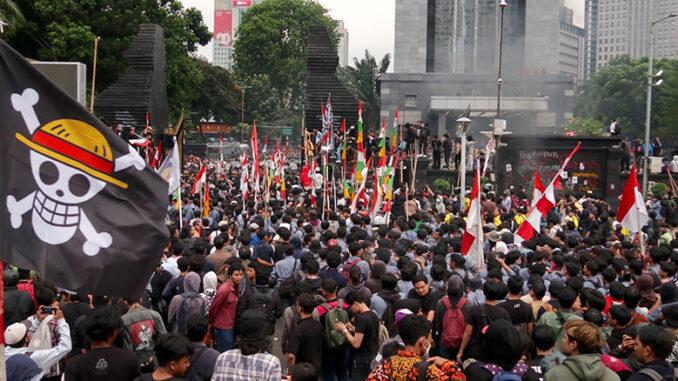
Jakarta’s unrest from 25 to 30 August 2025 posed a significant challenge for President Prabowo Subianto’s administration, revealing a government seen as detached from urgent political and economic issues. The largely leaderless protests were driven mainly by students, online motorcycle taxi (ojol) drivers, and Gen Z citizens, motivated by economic hardship, elite privilege, and political indifference. The unrest tragically peaked on 28 August when a police tactical vehicle fatally struck Affan Kurniawan, an ojol driver. Video footage rapidly spread on social media platforms such as YouTube, Instagram, and TikTok, amplifying public outrage and mobilisation.
This essay modestly modifies Christakis and Fowler’s (2009[1]) concept of the “three degrees of influence,” which posits that behaviours, emotions, and norms spread through social networks up to three degrees of separation, to better account for the role of social media in extending influence beyond these traditional limits. By applying this adapted framework to the digital realm, it aims to shed light on how connections among students, activists, workers, and citizens were not only offline but also online, creating a hybrid form of demonstration that unfolded both in the streets and across social media platforms. This dual presence enabled rapid and widespread mobilisation, with grievances resonating far beyond immediate circles and without reliance on traditional leadership. In this way, the protests may be understood as an example of how leaderless, digitally and physically interconnected networks can swiftly trigger significant social and political unrest in contemporary Indonesia, reflecting shared economic frustrations among a youth demographic increasingly disconnected from established political elites.
Intersecting with the dynamics of social networks is the realm of elite politics, where competing interests and a perceived detachment between political elites and the broader public appear to have heightened social tensions. In particular, contentious issues such as parliamentary housing allowances and stark social inequalities criticised by demonstrators have exacerbated grievances. These political concerns, intertwined with wider economic frustrations, formed a potent catalyst for mobilisation.
Indeed, the protests must be considered against Indonesia’s challenging economic backdrop. Evidence points to a contracting middle class, rising inflation, job insecurity, and soaring living costs—factors that exert significant pressure on ordinary citizens. These material hardships provided the underlying impetus for collective unrest, fuelling the widespread discontent witnessed during the demonstrations.
Further enriching this analysis is Aspinall’s (2025[2]) notion of demonstrations as sub-cultural expressions. Protesters seemed to forge an oppositional identity by sharing grievances and cultural symbols across social media platforms, thereby challenging entrenched elite privilege and systemic injustice. This cultural-symbolic resistance adds a vital dimension to understanding the multifaceted nature of the protests.
Together, these perspectives suggest that the 2025 Indonesia protests were not isolated disruptions but complex, multidimensional phenomena resulting from the interplay of network-driven mobilisation, elite discord, socio-economic strain, and broader socio-cultural dissent. The protests, sparked by perceived elite privileges amidst deteriorating economic conditions—including job losses, inflation, and a shrinking middle class—may thus be viewed as almost inevitable manifestations of underlying tensions.
The Indonesian middle class, once a keystone of economic stability, now faces serious challenges. The World Bank[3] (2021) defines this group as those with economic security, consuming roughly Rp 1.2 million to Rp 6.0 million monthly (equivalent to US$7.75 to US$38 daily, PPP-adjusted). Recent studies reveal significant contraction in this demographic, threatening national growth, social cohesion, and stability. Inflation surpassing wage growth has eroded purchasing power, plunging many middle-income households into precarious financial situations among worsening economic conditions.
Finally, a poignant example of how social media shaped public mobilisation was the rapid circulation of footage depicting a Brimob police tactical vehicle running over motorcycle taxi driver Affan Kurniawan. This incident vividly illustrated the intertwining of digital platforms with physical events, amplifying public outrage and fuelling widespread mobilisation.
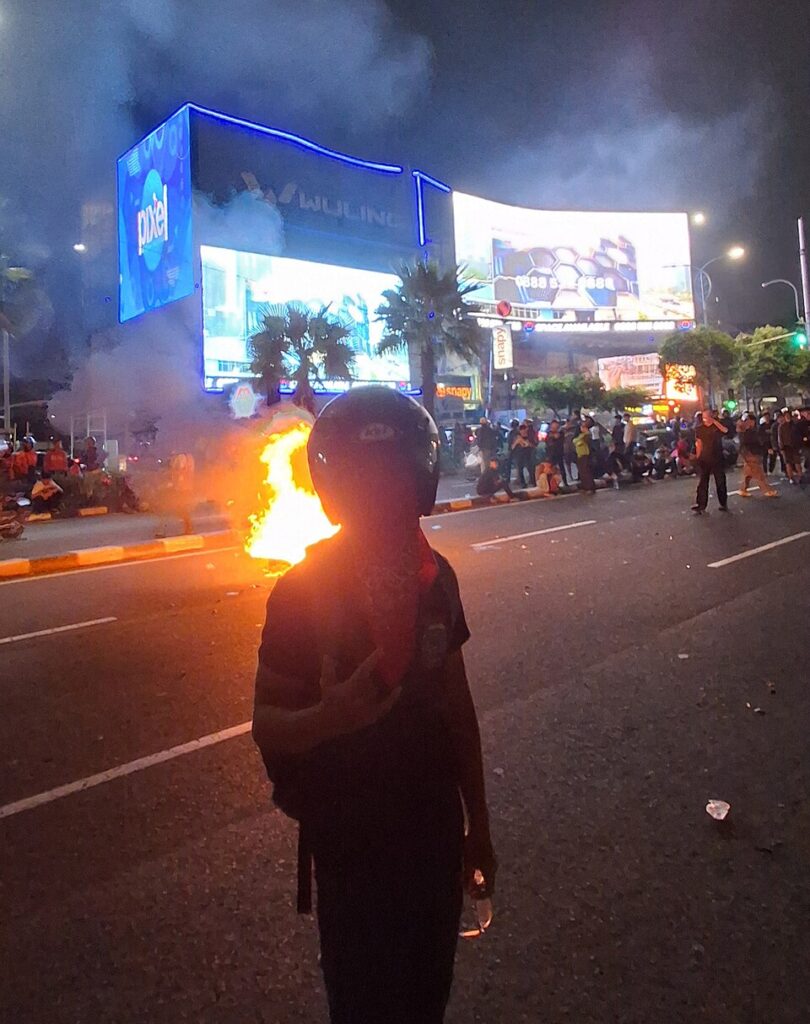
Literature Review
Edward Aspinall’s (2025) analysis highlights a clear divide between Indonesia’s entrenched, often patrimonial elites and a vibrant youth-led protest subculture, alienated from formal politics and voicing deep grievances over corruption and inequality. However, his binary framing somewhat overlooks the complex, fluid digital networks that underpin mobilisation today, where peer-to-peer sharing and social media algorithms sustain protest identity beyond rigid divides. Integrating social network theory could provide a richer understanding of evolving protest and elite-public dynamics.
Meanwhile, A’yun et al. (2025)[4] reveal how intra-elite competition can exploit protests for power struggles, often leading to violence detached from grassroots aims. Yet, this view may underestimate the autonomous role of horizontal online interactions that foster grassroots collective identities independent of elite control.
Both perspectives underplay the hybrid nature of protest networks—where offline and online interactions intertwine—and lack empirical detail on how network structures influence mobilisation and elite responses. Christakis and Fowler’s (2009) “three degrees of influence” theory provides a useful framework, emphasising contagion effects and sociostructural factors that shape protest diffusion. Their theory suggests that behaviours and emotions spread through social networks up to three degrees of separation, reflecting the layered interconnectedness of social life. Yet, in today’s hyperconnected digital environment, influence can extend beyond these limits, as emotive events prompt rapid sharing and contagion even among distant strangers.
This framework helps explain the Indonesia riots of August 25–30, 2025, where systemic grievances over elite corruption, economic hardship, and political indifference interacted with social contagion. The protests—initially sparked by parliamentary housing allowance hikes and intensified by the killing of motorcycle taxi driver Affan Kurniawan during demonstrations—spread rapidly online and offline, mobilising diverse social groups.
This suggests that social contagion operates within a rich political-economic context. Grievances about inequality and institutional legitimacy shaped not only mobilisation patterns but also the scale and intensity of collective action in both physical and digital spaces. The rapid networked spread of dissent reveals how localised discontent can escalate into widespread unrest within a hyperconnected society.
At the same time, Indonesia’s political economy is challenged by a shrinking middle class, rising job insecurity, inflation, and declining purchasing power, especially among urban middle-income groups. These economic pressures have provided fertile ground for mobilisation, intertwining material grievances with social and political frustrations to fuel unrest.
Christakis and Fowler’s contagion model offers a more nuanced understanding of influence diffusion than earlier Arab Spring scholarship (Gladwell 2010[5]; Eltantawy and Wiest 2015[6]), portraying social media not merely as a mobilisation tool but as a dynamic network where collective behaviours organically multiply.
In short, the Indonesia protests reflect the intersection of socio-economic hardship, elite-public divides, and digitally mediated social contagion, revealing the complex, multilayered dynamics of political mobilisation in contemporary Indonesia.
During a break in the 2025 Annual Session, several members of parliament were shown dancing, drawing criticism from netizens amid economic hardship (15 Aug. 2025).
Economic Grievances as Catalysts for Network Activation
The BPS (Indonesian Statistics Office) has recorded a significant decline in the middle-class population, which fell from 57.33 million in 2019 to 47.85 million by 2024[7]. This contraction, largely a consequence of the economic disruptions following the Covid-19 pandemic, is linked to weak consumption and limited access to employment opportunities that provide wages commensurate with middle-class living standards. Additionally, a sizeable share of the workforce remains employed in low-wage, informal sectors without adequate job security, thereby restricting the ability of many Indonesians to achieve and sustain a middle-class status.
Building further on this demographic shift, the LPEM[8] Indonesia Economic Outlook Q2-2025 report “Entering Growth Below 5” offers a comprehensive analysis of Indonesia’s middle class from 1993 to 2023, highlighting evolving consumption patterns and changes in economic standing. Historically comprising the middle 60% of income earners and serving as a key driver of domestic consumption growth, this group’s share of household consumption has steadily declined from approximately 49.8% to 47.5% over the past three decades. This decline starkly contrasts with the significant increase in consumption share among the wealthier upper 20%, particularly those in the 91st to 99th income percentiles, illustrating the growing economic disparities within Indonesian society.
The LPEM report notes that this shift illustrates the middle class’s changing fortunes throughout various economic cycles. It highlights that the middle class contracted significantly before the Asian Financial Crisis (1984–1996), during which the top 10% expanded considerably. Although there was a brief recovery following the crisis, the middle class’s share declined again from 2000 to 2019, as the top 20% increased their share at the expense of both lower-income and middle groups. The report points out that, even during the Covid-19 pandemic when some resilience was seen among the bottom 20%, the middle class’s share continued on a downward trajectory. Furthermore, the 2022–2023 recovery revealed a U-shaped consumption distribution, with upper and lower income groups expanding their shares, underscoring economic fragilities and rising inequality, as evidenced by the Gini Index increasing from 35.3 in 2020 to 36.1 in 2023. According to the report, this diminishing consumption share not only signals reduced economic security for the middle class but also portends challenges for domestic demand, inclusive growth, and social cohesion.
Beneath the surface disturbances in Indonesia’s economy lies a more profound malaise. Household consumption, which accounts for over half of the nation’s GDP, has weakened noticeably due to declining purchasing power and limited mobility. This is starkly reflected in the sharp drop in car sales growth from a robust 14.82% to a mere 3.77% in late 2024, highlighting a significant contraction in domestic demand among middle- and lower-income groups.[9]
Although headline inflation remained modest at around 1.87% year-on-year by mid-2025, rising costs for essentials such as food and housing continue to impose substantial burdens on many households[10]. Meanwhile, the persistently high unemployment rate, close to 5%[11]—the highest in the ASEAN region—exceeds those of neighbouring countries including the Philippines (4.5%), Malaysia (3.2%), Vietnam (2.0%), Thailand (1.0%), and Singapore (2.0%).
This elevated unemployment reflects deep structural challenges within Indonesia’s labour market, such as inadequate job creation relative to workforce growth and a large informal and underemployed labour segment. Despite Indonesia’s sizable and growing economy, these issues underscore significant shortcomings in economic inclusion and the quality of employment opportunities compared to regional peers.
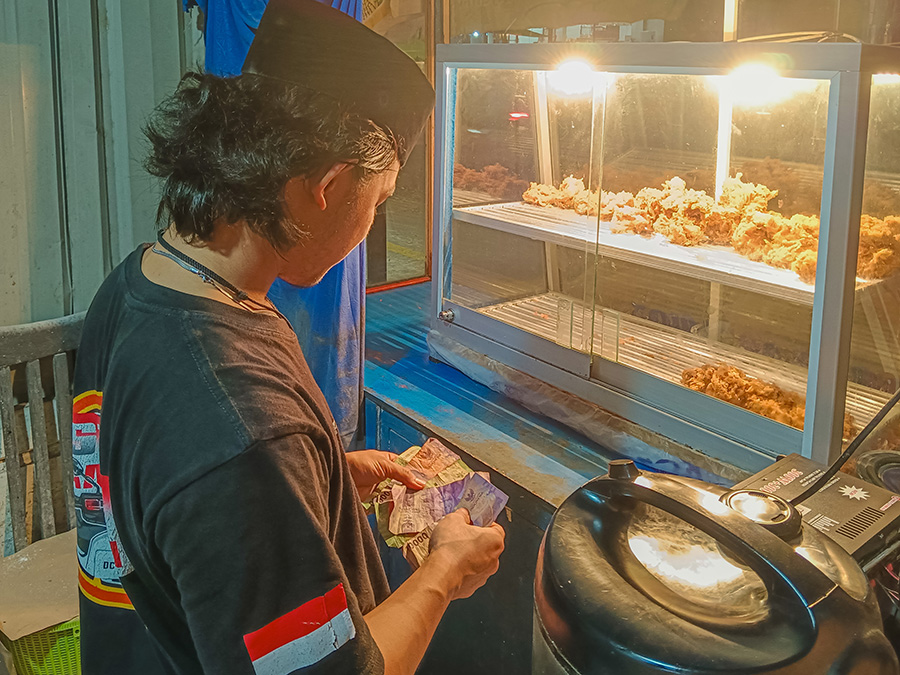
Halimatusa’diyah (2025[12]) highlights that Indonesian youth face significant challenges in securing their “dream” jobs. In her 2024 survey, Halimatusa’diyah reveals that over 72% of Indonesian university students consider securing their preferred employment to be “difficult,” with a further 3.59% describing it as “impossible.” This marks the highest level of youth dissatisfaction among six Southeast Asian countries surveyed. She also highlights a notably high youth unemployment rate of 16.16%, which is more than three times the national average of 4.76%. These figures considerably surpass those of neighbouring countries such as Thailand and Vietnam, where education tends to be more closely aligned with labour market demands.
Moreover, Halimatusa’diyah points out that over half of working Indonesian youth (aged 15–24) are engaged in the informal economy, frequently in low-paid or unpaid roles lacking social protection. This precarious employment, alongside disparities in urban job distribution and opaque recruitment methods, contributes to making Indonesia’s youth labour market among the most challenging in Southeast Asia.
Further insight is provided by Wihardja and Basri (2025[13]), who observe a concerning shift in Indonesia’s labour market dynamics. They report that the proportion of new jobs created within the informal sector increased from 49.5% in 2018 to 51.5% in 2023, while underemployment rose from 28.8% to 31.0%. The authors suggest that this trend signals a decline in job quality, disproportionately impacting the middle class, which relies on formal, secure employment to maintain their standard of living. They note that the rise in informal employment reflects broader vulnerabilities in economic stability and limited access to quality jobs, factors that directly undermine the financial security and purchasing power of the middle class.
Supporting this, the World Bank’s 2021 “Pathways to Middle-Class Jobs in Indonesia”[14] report underscores the critical importance of secure and well-paid employment for maintaining a middle-class standard of living. Yet, the steady increase in informality and underemployment challenges the availability of such jobs, threatening the crucial role the middle class plays in Indonesia’s socio-economic fabric.
The report mentions that middle-class consumption growth has languished at a modest 1.3% per annum between 2019 and 2024, significantly trailing behind the 2-3% growth recorded for lower-income groups and the 3% for the upper class. This gradual contraction within the middle class has naturally coincided with a surge in the gig economy workforce, which estimates suggest about 2.3 million individuals who primarily rely on gig work for their livelihoods in Indonesia[15]. Such a substantial and diverse gig workforce undoubtedly exposes underlying weaknesses in Indonesia’s labour market and broader economic resilience.[16]
Moreover, the Indonesia Deposit Insurance Corporation reports a worrying deceleration in savings growth among the lower middle class. Specifically, deposits under IDR 100 million—largely reflective of the most financially vulnerable—grew by 4.76% in July 2025, declining slightly from 4.89% in June 2025 and 4.86% in July 2024 (Hannany et al., 2025[17]). This persistent downward trend implies that many middle-class households are increasingly depleting rather than building their savings, likely to meet everyday expenses during ongoing economic strain. The fact that savings growth is slowing even amid inflationary pressures highlights the limited capacity of households to buffer themselves against rising costs and income stagnation.
This economic vulnerability has contributed to widespread public dissatisfaction, which underpins the current unrest in Indonesia. Deep-seated perceptions of government neglect, exacerbated by punitive tax hikes severely straining household incomes, have fuelled discontent. Despite President Prabowo’s repeated calls for fiscal discipline, his administration is challenged by an oversized cabinet and incoherent policies that have steadily eroded public trust and worsened the crisis.
Intensifying these political difficulties is a marked generational divide, with the 73-year-old President relying heavily on a small, relatively inexperienced group of advisers who concentrate power within a close inner circle. This concentration risks suppressing policy diversity and critical debate, fostering a culture resistant to dissenting views and fresh ideas essential for responsive governance. More troublingly, there has been a pronounced militarisation of the government since Prabowo took office in October 2024, with former military officers—many linked to his elite Kopassus background—occupying a majority of key cabinet positions. This shift has weakened parliamentary oversight and consolidated executive power reminiscent of Indonesia’s authoritarian past.
This militarisation extends into various sectors via military-led task forces overseeing labour, infrastructure, and agricultural reforms, often prioritising order and rapid enforcement over participatory governance and transparency. Meanwhile, civil liberties face increasing restrictions: press freedoms are curtailed, protests met with repression, and legislative changes undermine regional autonomy, escalating social tensions. Together, these developments reflect a governance approach prioritising control and stability, potentially at the expense of democratic norms, civic freedoms, and the inclusive dialogue essential to resolving the underlying economic and social grievances driving the unrest.
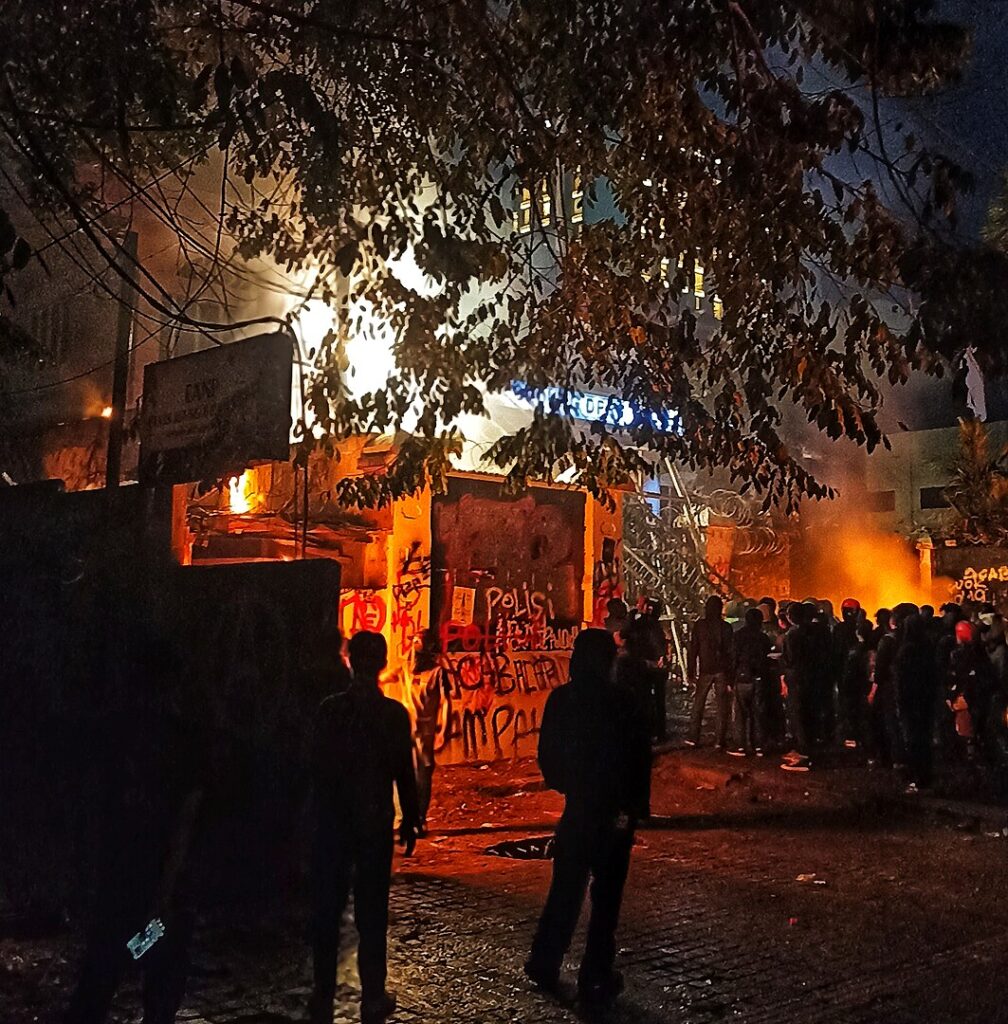
The Spread and Amplification of Protest Behaviour through Social Networks
Before reflecting on the role social media played during the recent protests, it seems worthwhile to first consider the scale and context of the demonstrations themselves. Between 25 and 30 August 2025, Indonesia experienced considerable protest activity spanning numerous cities—not just Jakarta, which is often mistakenly thought of as the capital, but across the archipelago. According to figures from the Minister of Home Affairs, from 25 August to 7 September, there were 228 demonstrations in at least 144 cities and regencies. It would therefore appear reasonable to suggest that roughly 50 cities saw protests within that initial five-day period.
Participation varied in size, yet tens of thousands of people collectively took to the streets. Major urban centres such as Jakarta, Yogyakarta, Surabaya, and Bandung saw notably large gatherings, with crowds filling public spaces and thoroughfares. This mobilisation might be described as hybrid in nature, combining physical presence on the streets with active engagement on digital platforms. The anger and frustration expressed by protesters in these cities were clearly reflected and amplified on social media, revealing a strong emotional connection between what was happening on the ground and the conversations online. At times, this shared anger on the streets found its expression in more intense actions, including the burning of police stations in several locations, the attack on the Brimob headquarters in Jakarta, and damage to buildings housing regional parliaments—demonstrations of discontent that resonated deeply within digital discussions as well.
Indeed, social media platforms, especially X, seem to have played a significant, if complex, role in shaping the conversation around these events. Analysis by Drone Emprit (2025[18]) suggests that the most influential voices on X were a blend of critical public figures and media outlets. Community leaders emerged prominently among those advocating for action, while others voiced more cautious or questioning perspectives regarding the protests. Established media organisations also appeared to influence the framing of issues through detailed reporting. Accounts with the highest engagement related to the demonstrations included @Boediantar4 (1379 engagements), @barengwarga (1034), @ilhampid (636), @kompascom (716), and @tempodotco (1393).
Sentiments largely expressed online seemed to be dominated by feelings of anger and sadness, primarily directed towards the House of Representatives (DPR) and law enforcement. Common themes involved frustrations over perceived ineffectiveness of DPR members, alleged insensitivity to the public’s condition, concerns around corruption, and criticism of the police’s handling of protesters.
On 28 August 2025, a tragic incident occurred during the protests when a Brimob tactical vehicle ran over an online motorcycle taxi (ojol) driver named Affan Kurniawan in Central Jakarta. The deeply distressing clip of the event is estimated to have been viewed and shared between 6.5 and 10 million times within just 24 hours. Such rapid dissemination highlights not only the power of contemporary social media but also the profound emotional impact this incident has had on the public collective consciousness. Affan was reportedly trying to retrieve his fallen phone when he was hit and run over by the vehicle. Despite efforts to save him at the hospital, he passed away from fatal injuries. This incident sparked widespread outrage, and protests.
Analysis of publicly available data on views and engagement across major video and social media platforms indicates that the footage garnered roughly 4,500 to 7,000 views and shares every minute during this initial period. TikTok accounts affiliated with prominent news and media organisations—such as @suaradotcom, @obrolanpodcast, @inilahcom, and @metro_tv—have been used to provide estimates, given the current difficulty in collecting exact data. These accounts, each boasting hundreds of thousands or millions of followers, swiftly amassed millions of views and considerable public engagement. For example, as of 2025, @suaradotcom had approximately 2.3 million followers, @inilahcom around 1.5 million, @obrolanpodcast about 1.1 million, and @metro_tv roughly 1.7 million. Notably, a TikTok video by @detikcom titled “Pengemudi ojek online, Affan Kurniawan, tewas dilindas rantis Brimob” attracted some 370,600 likes, reflecting strong public interest and engagement. This widespread sharing fuelled national outrage and helped mobilise protests beyond Jakarta, underscoring the powerful influence of social media in shaping public discourse during critical moments.
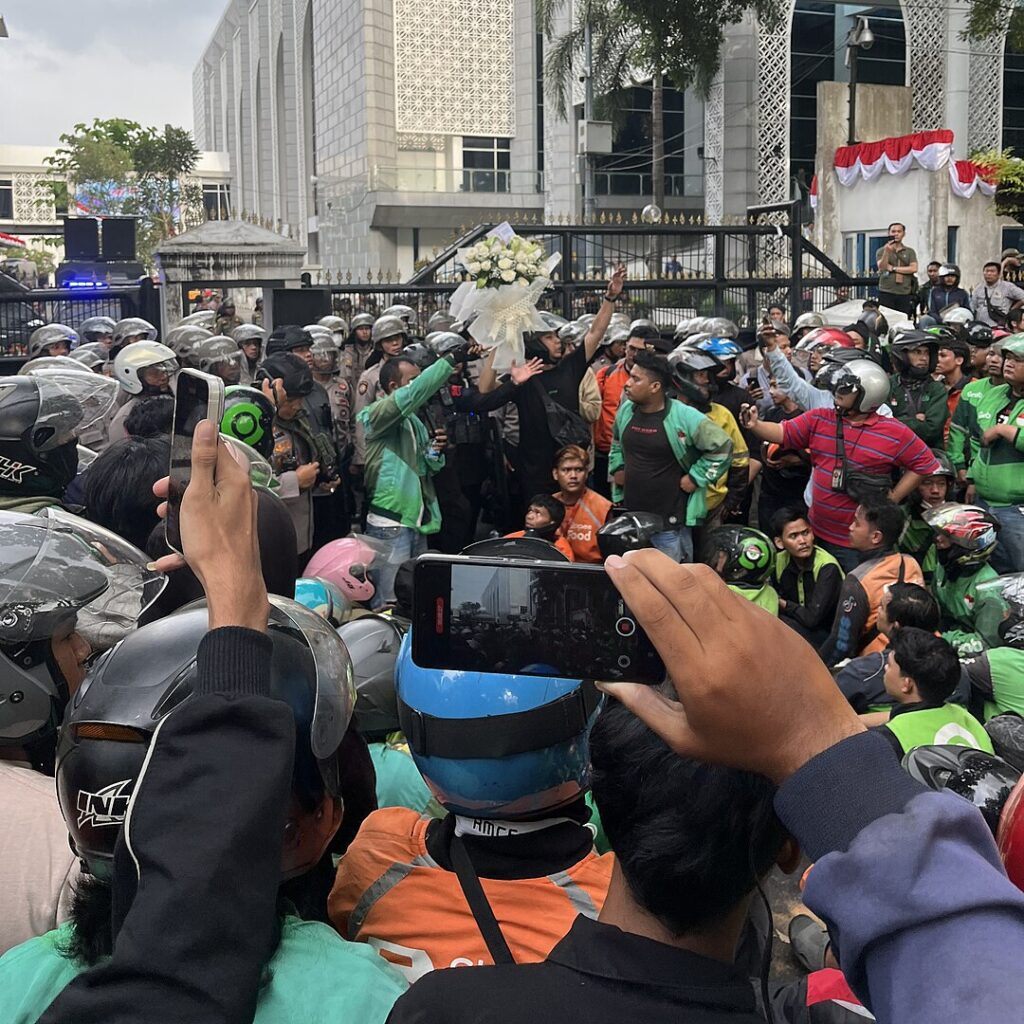
Social media played a significant role in shaping the August 2025 protests in Jakarta, serving not only as a source of information but also as a tool for mobilisation across diverse groups. Data from Drone Emprit[19] shows that top Instagram accounts, including @Kompas.com (7 posts, 100,923 engagements) and @kumparan (3 posts, 51,252 engagements), generated a total of 20 posts and approximately 316,838 engagements during the protests. Meanwhile, the Monash Data & Democracy Research Hub[20] highlights that peak media mentions varied due to delays between online news sites and the platform X. Tribunnews led with 8,499 mentions, followed by Antaranews (6,946), Disway.id (3,982), bacakoran.co (3,929), kompas.com (3,902), voi.id (3,618), and jawapos.com (3,008). Together, social media and traditional news complemented each other in informing and mobilising the public.
These figures underscore the expansive reach and influence these accounts wielded in mediating the unfolding events on social media, facilitating the dissemination of information and supporting mobilisation throughout the protests in Jakarta from 25 to 28 August 2025.
Furthermore, TikTok emerged as a prominent platform amplifying the protests during this period, serving as not only an information-sharing medium but also a catalyst for mobilisation across various demographic groups. Influential TikTok accounts such as @voidotid (1.2 million followers), @suaradotcom (2.3 million), @detikcom (4.4 million), @millenialzkece (2.4 million), @officialtrans7 (8.6 million), and @officialinews (10.3 million) posted multiple videos capturing the demonstrations at the House of Representatives on 25 August. These videos, which attracted between 10 and 15 million views, depicted large crowds of students gathered outside the parliament and images of barriers erected at the DPR entrance, signalling imminent mobilisation and fostering a heightened sense of anticipation among viewers.
Beyond students, labour groups and ojol (motorcycle taxi drivers) extensively utilised TikTok and Instagram to organise and sustain momentum. These platforms enabled real-time livestreams sharing scenes of protests, police responses, and community solidarity—content that garnered millions of views and was crucial for mobilising wider participation beyond physical geography. For instance, ojol drivers circulated videos highlighting their collective presence at protest sites, emphasising both their economic grievances and symbolic role in the movement. However, due to concerns about escalating violence and misinformation, TikTok voluntarily suspended its Livestream feature in Indonesia for several days to moderate content.
These social media activities underline how digital networks intersect with offline peer groups to broaden protest participation. Students, labourers, and ojol drivers maintained tightly knit relational clusters via messaging apps like WhatsApp and Telegram, but platforms such as TikTok expanded reach exponentially by enabling sharing beyond immediate social circles. Christakis and Fowler’s social contagion model captures this process—participation cascades through multiple degrees of connection, generating rapid diffusion and clustering. The mobilisation of these distinct groups on digital channels not only enabled real-time coordination but also fostered a shared protest identity, magnifying the scale and intensity of the August 2025 protests in Indonesia.
TikTok and Digital Mobilisation
The data presented in Table 1 indicates a substantial escalation in social media activity surrounding the protests from 25 to 29 August 2025. The general hashtag #demo exhibited a steady increase, culminating in a notable peak of 7,000 mentions on 29 August. Similarly, specific hashtags such as #mahasiswademo, #demodpr, and #dpr also saw significant growth, highlighting increased engagement particularly regarding student protests and criticism of the House of Representatives.
This marked rise towards the end of August suggests rapid intensification of public discourse and mobilisation, likely corresponding with key protest events and broader media attention. The prominence of hashtags focused on parliamentary issues underscores political dissatisfaction intertwined with grassroots activism.
Table 1: Daily Posting Volume of TikTok Protest Hashtags (25-29 August 2025)[21]
|
Date |
#demo |
#mahasiswademo |
#demodpr |
#dpr |
|
2025-08-25 |
1500 |
900 |
600 |
800 |
|
2025-08-26 |
1400 |
800 |
550 |
850 |
|
2025-08-27 |
1800 |
1200 |
700 |
900 |
|
2025-08-28 |
5000 |
3000 |
2800 |
3500 |
|
2025-08-29 |
7000 |
4200 |
4100 |
5200 |
Sources: various social media, calculation assisted by AI
TikTok played a pivotal role during the August 2025 protests, serving not only as a platform for sharing information but also as a catalyst for mobilisation across diverse demographics. Despite some voluntary restrictions on TikTok’s live streaming amid escalating violence, the platform remained central to documenting events and amplifying protest narratives. Analysis of protest-related hashtags demonstrates how digital communication facilitated rapid information dissemination and emotional mobilisation, complementing offline activism and underscoring the hybrid nature of the protest movement.
Between 25 and 29 August, activity under these hashtags surged, paralleling offline protests and key moments, notably following the death of motorcycle taxi driver Affan Kurniawan on 28 August—a trigger that catalysed widespread outrage. Peak activity on 28 and 29 August involved thousands of videos posted daily, achieving millions of views, likes, shares, and comments.
Although Jakarta was the focal point of protests, hashtagged content originated from across Indonesia, including Surabaya, Bandung, Medan, Makassar, and Yogyakarta. This geographical dispersion in digital activism suggests that the protest issues resonated widely beyond the capital, touching upon economic, political, and social concerns across diverse urban settings—indicating a collective mobilisation nationwide.
The spatial diffusion of digital activism not only emphasises the protests’ significance within Jakarta but also points to the potential for a wider, more inclusive national discourse. While acknowledging the need for critical examination of context and nuances, the evidence suggests extensive engagement illustrating social media’s role in linking local grievances to broader civic narratives.
Table 2: Geographical Distribution of TikTok Protest Posts (Approximate Count)
|
City |
Posts |
|
Jakarta |
12,000 |
|
Surabaya |
3,200 |
|
Bandung |
1,800 |
|
Medan |
1,500 |
|
Makassar |
1,300 |
|
Yogyakarta |
1,100 |
Sources: various social media, calculation assisted by AI
Jakarta contributed the majority of digital activity, consistent with its role as the political and protest epicentre. Nonetheless, significant participation from other cities illustrates the protests’ broad reach. Such figures invite reflection on how digital discourse mirrors population size, political engagement, and regional contexts across Indonesia.
Drawing upon the Monash Data & Democracy Research Hub (2025), the emotional tone of online conversations from 25 to 31 August revealed a dynamic evolution. From 25 to 27 August, approximately 20% of posts expressed anticipation, reflecting hopes that the protests might effectively convey public grievances. On 28 August, anger surged to 26% of postings, coinciding with escalated confrontations and the tragic death of Affan Kurniawan, which intensified online discourse. In the peak days, 29 and 30 August, anger remained prevalent, accompanied by fear (12%) regarding possible repression, sadness (11.5%) mourning Affan’s death, and surprise (11.3%) responding to unfolding events. These findings underscore social media’s vital role as a medium for collective emotional expression during this significant moment.
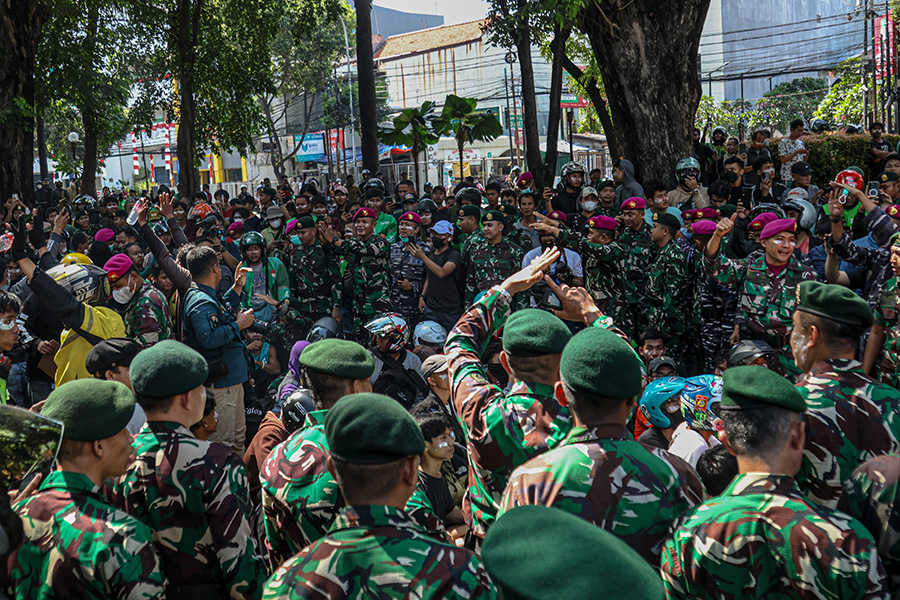
Conclusion
This essay utilises and extends Christakis and Fowler’s (2009) influential theory of the “three degrees of influence,” situating the 2025 Jakarta demonstrations within the broader framework of social contagion and networked mobilisation. While their theory highlights how behaviours, emotions, and social norms propagate up to three degrees of separation within social networks, this study reveals how the hyperconnected digital landscape of contemporary Indonesia magnifies and accelerates these contagion effects beyond traditional social boundaries. Through the interplay of offline and online networks, information and mobilisation cascaded rapidly across tightly knit social clusters and expansive digital communities, creating a collective response that transcended immediate personal ties.
Moreover, this analysis integrates political-economic grievances—such as economic hardship, elite dissonance, and institutional distrust—as critical contextual factors that shape the readiness and intensity of network influence. These material conditions act as potent catalysts activating and amplifying social contagion processes within Indonesia’s multilayered and digitally mediated social fabric.
By foregrounding both the structural pathways of influence and the substantive economic and political forces at play, this essay provides a richer, more layered understanding of protest dynamics. It underscores that contemporary mobilisation is neither purely spontaneous nor merely elite-driven but emerges from the complex synergy of social network contagion operating within a hyperconnected society facing profound socio-economic challenges.
Wahyu Prasetyawan
Associate Professor, Syarif Hidayatullah Islamic State University, Jakarta, Indonesia
Notes –
[1] Christakis, N. A. and Fowler, J. H. (2009) Connected: The surprising power of our social networks and how they shape our lives. Boston: Little, Brown and Co.
[2] Edward Aspinall. 2025. Mass protest and the two worlds of Indonesian politics. https://www.newmandala.org/mass-protest-and-the-two-worlds-of-indonesian-politics/
[3] World Bank. 2021
https://documents1.worldbank.org/curated/en/519991580138621024/pdf/Aspiring-Indonesia-Expanding-the-Middle-Class.pdf
[4] Rafiqa Qurrata A’yun, Ary Hermawan and Abdil Mughis Mudhoffir. 2025. The battle of the giants: How elite conflicts turn Indonesian protests into mass riots . https://indonesiaatmelbourne.unimelb.edu.au/the-battle-of-the-giants-how-elite-conflicts-turn-indonesian-protests-into-mass-riots/
[5] Gladwell, M. (2010). Small Change: Why the revolution will not be tweeted. The New Yorker, 4 October. Available at: https://www.newyorker.com/magazine/2010/10/04/small-change-malcolm-gladwell [Accessed 6 Sep. 2025]
[6] Eltantawy, N. and Wiest, J.B. (2015). What Was the Role of Social Media During the Arab Spring? SSRN Electronic Journal. Available at: https://papers.ssrn.com/sol3/papers.cfm?abstract_id=2595096 [Accessed 6 Sep. 2025].
[7] https://alphasoutheastasia.com/indonesias-middle-class-population-drops-to-48m/
[8] https://en.lpem.org/indonesia-economic-outlook-q2-2025/
[9] https://fiskal.kemenkeu.go.id/files/red/file/1745830563_2025_april_red.pdf
[10] https://www.indonesia-investments.com/finance/macroeconomic-indicators/item16
[11] https://www.indonesia-investments.com/finance/macroeconomic-indicators/item16
[12] Iim Halimatusa’diyah. 2025. Why are Dream Jobs a Difficult Reality for Indonesian Youth? https://fulcrum.sg/why-are-dream-jobs-a-difficult-reality-for-indonesian-youth/
[13] Maria Monica Wihardja|Chatib Basri. 2025. Growing or Shrinking? How Indonesia’s Middle Class is Really Doing. https://fulcrum.sg/growing-or-shrinking-how-indonesias-middle-class-is-really-doing/
[14] World Bank. 2021. Pathways to Middle-Class Jobs in Indonesia. https://www.worldbank.org/en/country/indonesia/publication/pathways-to-middle-class-jobs-in-indonesia
[15] M Syarahil M Effendi. 2024. Indonesia’s gig workers are precausly. Can we fix the platform economy. https://indonesiaatmelbourne.unimelb.edu.au/indonesias-gig-workers-are-living-precariously-can-we-fix-the-platform-economy/
[16] World Bank. 2021. Pathways to Middle-Class Jobs in Indonesia. https://www.worldbank.org/en/country/indonesia/publication/pathways-to-middle-class-jobs-in-indonesia
[17] Zetta Hannany, Kholid Rafsanjani, Nina Rosdiana 2025. Indonesia’s lower middle-class savings thinning, says LPS. https://www.idnfinancials.com/news/56903/indonesias-lower-middle-class-savings-thinning-says-lps
[18] https://x.com/DroneEmpritOffc/status/1960332285645074673/photo/1
[19] Drone Empritt. 2025. https://x.com/DroneEmpritOffc/status/1960332310387319293/photo/1
[20] Monash Data & Democracy Research Hub. 2025.
Jejak Emosi dan Polarisasi Sosial di Ruang Digital: Analisis Protes Publik Agustus 2025
[21] Sources: Al Jazeera. (2025, August 31). Indonesian groups delay protests in Jakarta as police tighten security. https://www.aljazeera.com/news/2025/9/1/indonesia-tightens-security-after-deadly-protests
BBC. (2025, September 1). How the death of a delivery driver ignited Indonesia. https://www.bbc.com/news/articles/c2dj9w306wzo
KontraS. (2025, August 31). International solidarity protecting the right to protest. https://kontras.org/artikel/international-solidarity-protecting-the-right-to-protest-international-solidarity-with-indonesia-stoppolicebrutality
TIME. (2025, September 1). What to know about protests in Indonesia. https://time.com/7313691/indonesia-protests-bali-jakarta-food-delivery-driver-death-prabowo-subianto/
